“Each emotional system is hierarchically arranged throughout much of the brain, interacting with more evolved cognitive structures in the higher reaches, and specific physiological and motor outputs at lower levels.” Jaak Panksepp
Watch our interview on YouTube here https://youtu.be/siJ1FUeUD40
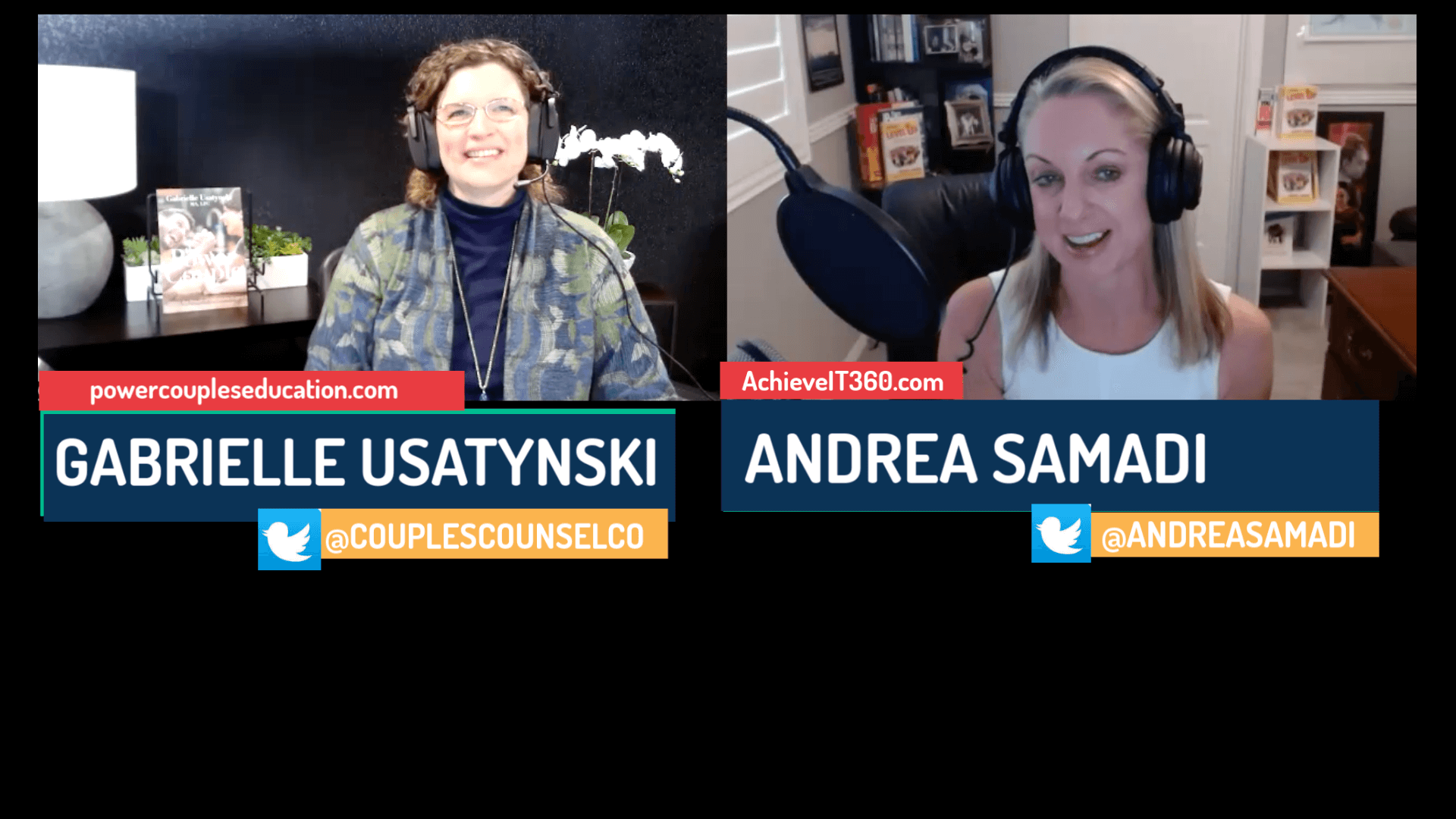
On today’s Episode #282 we will cover
✔ How Gabrielle Usatynski's NEW book The Power Couple Formula, Applies Jaak Panksepp's 7 Core Emotions to Transform Your Relationships, Family, Career and Life.
✔ What We Should All Know About The Attachment Theory.
✔ A Deep Dive into Each of the 7 Core Emotions and How They Map in the Brain.
Welcome back to The Neuroscience Meets Social and Emotional Learning Podcast, where we cover the science-based evidence behind social and emotional learning (for schools) and emotional intelligence training (in the workplace) with tools, ideas and strategies that we can all use for immediate results, with our brain in mind. I’m Andrea Samadi, an author, and educator with a passion for learning specifically on the topics of health, wellbeing and productivity, and launched this podcast to share how important an understanding of our brain is to our everyday life and results using the most current brain research. If there’s a tool, strategy or resource that I find, that could be helpful to improve productivity and results, whether we are a teacher in the classroom, a coach or in the modern workplace, I will share it here.
On today’s episode #282, we will be speaking with an important guest, who reached out to me shortly after we released EPISODE #270 with Lucy Biven[i] who co-authored The Archeology of Mind, with Jaak Panksepp. She let me know she was a couple’s therapist, educator and an author, with a new book coming out next month and was amazed to see our episode with Lucy Biven, as she cites The Archeology of Mind on nearly every page of her new book, The Power Couple Formula: Unlock the Power of Your Instincts and Transform Your Relationship. She even mentioned that a colleague of Dr. Panksepp, Dr. Doug Watt, was currently reviewing her manuscript to offer his guidance on the subject.
When this email came through, I was taking a short break from interviews, gathering my bearings with a tight schedule, but when I saw this email, I knew I had to learn more about our next guest, Gabrielle Usatynski, and her new book, the Power Couple Formula.
We met briefly to chat, and I’ve got to say that we could have recorded that conversation. She spoke eloquently about her background as a therapist, and the history of our emotions. I couldn’t take notes fast enough, but saw that not only does Gabrielle understand Jaak Panksepp’s work (that many find to be difficult) but she could explain it in a way that made sense to me, with examples of how to each of the core emotions.
A bit about Gabrielle:
BIO:
Gabrielle Usatynski, MA LPC is the founder and director of Power Couples Education. An internationally renowned therapist, speaker and educator, she is the author of the forthcoming book, The Power Couple Formula, scheduled for release this year. She is the originator of ground-breaking online programs that help couples build relationships based on safety and trust and offers professional training programs for therapists in the Power Couple Method.
Her work is regularly featured in such publications as CNN, USA Today, Cosmopolitan, Parents Magazine, Counseling Today, and Women’s Health.
For over a decade, Gabrielle has helped thousands of couples. Her clinical work has earned her numerous awards, including: the USA Prestige Award for Couples Counseling Service of the Year, the Best of Boulder Award for Couple and Marriage Counseling, and the Top 10 Best Marriage Counselors of Boulder, CO Award.
Gabrielle is a graduate of McGill University and also specializes in the treatment of traumatized children and their families.
So today, we will meet Gabrielle Usatynski, and learn how Jaak Panksepp’s work plays out in our most personal relationships, with tools that we can all use and apply right away.
Welcome Gabrielle, it’s incredible to see you again. Thank you for coming on the podcast to share your knowledge on what many of us would consider a topic that’s not the easiest to explain because most of us are still trying to understand this topic of our emotions and how they play out in our lives, specifically with our relationships. Thank you for being here.
You know I was thrilled to meet you as I just love learning, and making connections, especially when the topic is challenging, or makes you think a bit.
INTRO Q: I wanted to ask you first, before diving into your new book, The Power Couple Formula, Why did you write this book, and why did you focus on the work of Dr. Panksepp?"
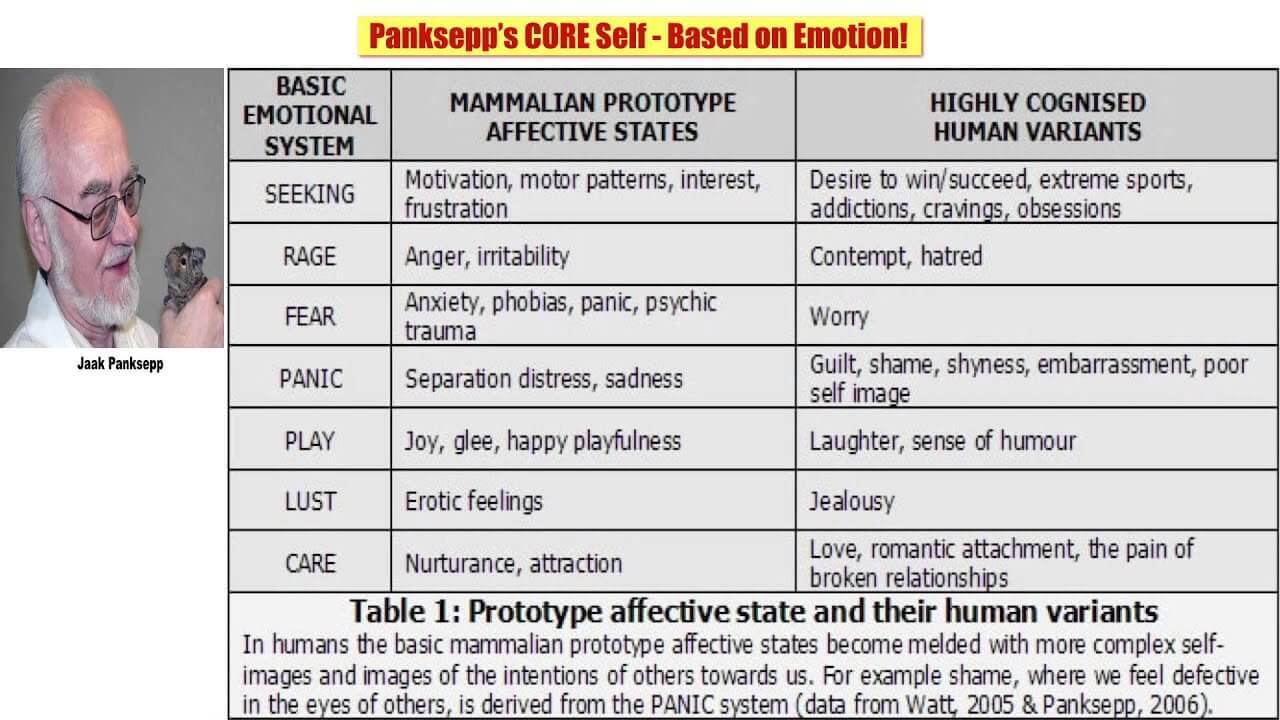
Q1: I put an image in the show notes of the 7 CORE emotions. Can you explain this chart I put in the show notes, and what Dr. Panksepp discovered about these emotions, that you found to be so important?
Q1B: What did Dr. Panksepp discover about where our emotions reside in the brain?
Q2: Can you orient us to what therapists were taught about our emotions, The Attachment Theory, and how important it is to completely deactivate this system in intimate relationships?
2B: Why should we understand Attachment Theory, and where does Affective Neuroscience come into this understanding?
Q3: How do we use your book as a map, with tools and resource to help us personally, with our family, career, or even with the work we are doing in the world?
When I first saw these 7 core emotions, I actually printed them and put them on my desk to see if I could notice them in my life. In the neuroscience certification course I took, we spent a lot of time on the PLAY system (especially as it relates to learning and our schools) but I wonder if we could take a look at your book, and go through 4 of the 7 action systems? Of course, I’d love to cover them all, but I picked the ones that stuck out to what I would think our listeners would like to dive deeper into.
Q4: I know that the PANIC/GRIEF system is important, especially as you’ve cited Dr. Bruce Perry who we had on the podcast. What are the impacts of early bonding on our physical and mental health?
Q5: What are some tools that could help de-activate panic/grief/rage in our relationships to avoid the conflict that goes along with it?
Q5B: As I was reading through the book, I saw that you have strategies to help ALL of the attachment styles. Wouldn’t it help people to know this BEFORE they marry someone so you can kind of guess how things would pan out during conflict?
Q6: To close out, is there anything important that we haven’t talked about, knowing that we didn’t cover all the core emotions, but to encourage people to read your book, and learn the strategies for ALL of the systems. What have we missed here?
Gabrielle, I want to thank you for coming on the podcast and sharing your new book with us. For people who want to learn more about you and your book, is the best place your website? https://powercoupleseducation.com
Final Thoughts
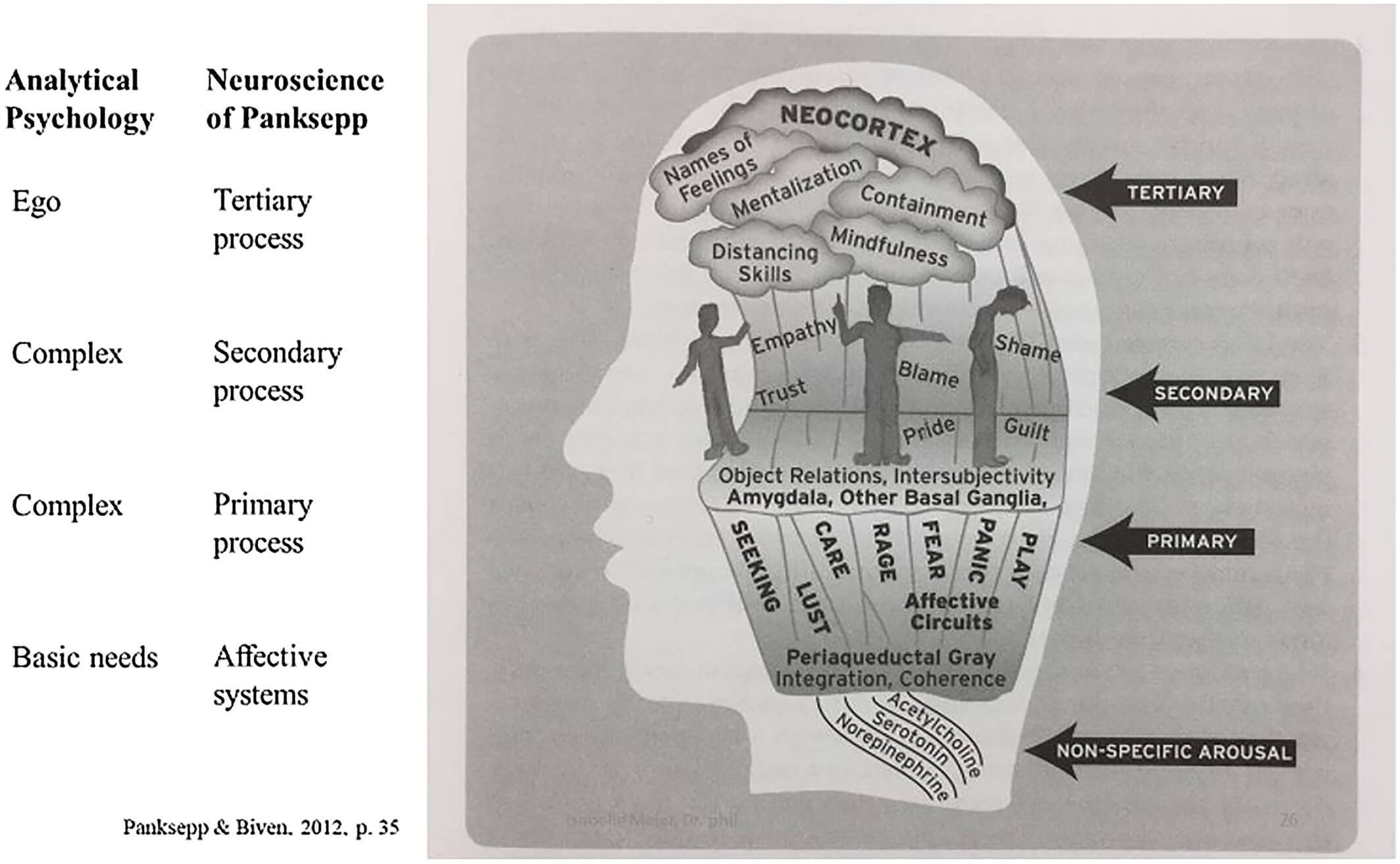
We opened up this episode with a quote from Dr. Panksepp that said “each emotional system is hierarchically arranged throughout much of the brain, and I think the image I put in the show notes and our YouTube interview clearly shows these 7 core emotions (or our 7 basic needs) that are hard-wired deep within our brain stem, bringing Dr. Panksepp’s quote to life in a way that we can now visualize these core emotions within the deepest, oldest part of our brain.
When I first began to study Dr. Panksepp’s work, I printed these core emotions and put them on my desk, for me to glance at throughout my day, and I wondered how they were showing up for me on a day to day basis. As I’m reflecting on Gabrielle’s book, and our interview, I’m doing so from how I think these core emotions have shown up in my daily life, and for you, it will be different, but I’m hoping that at least I’ve started the ball rolling to have us ALL think about how to take our understanding of ourselves to a deeper level, using Dr. Panksepp’s Core Emotions and Gabrielle’s book, as a map. Gabrielle was very thorough with her research that you will see within each chapter.
I can now see how these 7 core emotions interact with the “more evolved cognitive structures in the higher reaches” of my brain, and this understanding can now help me to see how each emotion I’m feeling, (that’s generated way deep down in the oldest part of my brain) and shows up behind the actions I’m taking. You’ll get a deeper understanding of why you feel a certain way, and why you do the things you do, with this book.
You’ll also get to look at why others close to you, do the things they do, as you begin to match Bowlby and Ainsworth’s Attachment Theory to your most intimate relationships.
What did I notice with each action system?
SEEKING, RAGE/Anger, FEAR, LUST, CARE, PANIC/Sadness, and PLAY.
Seeking: This core emotion is evident with my need to connect with others around the world and this need is about getting more out of life with continual research and learning. While I can’t jump on an airplane and travel to Australia, India, Sweden or South African (at least not this week), and have conversations with curious minds like myself, I can write and release podcast episodes that travel around the world, to you, on my behalf. This kind of helps with this action system and keeps me working, and researching.
I also need to seek others to learn from, and when the research becomes difficult, I can remember what Dr. Zadina[ii] said on our recent episode, where she would find articles that she was interested in first (seeking) and then read them over and over again, gaining more understanding each time.
When you read Ch. 5 in Gabrielle’s book, you can learn how secure seeking develops in relationships, so that you can support your partner with ways that each of you can continue to expand, learn and grow together.
- That’s what I learned about the how I interact with the seeking system. What about you? Where do you notice this core emotion of SEEKING plays out in your life?
Rage/Anger: Some people I’ve noticed get angry easily, for different things. My oldest daughter doesn’t like injustice, I don’t like disorder, but the key is to notice what makes this emotion come out in you, and know it’s hard-wired deep in our brain stem, so that when this emotion sets you off, that you find a strategy to help create more space between the stimulus (the thing that you didn’t like) you’re your response to it. I’ve noticed that meditation has helped me be less reactive here.
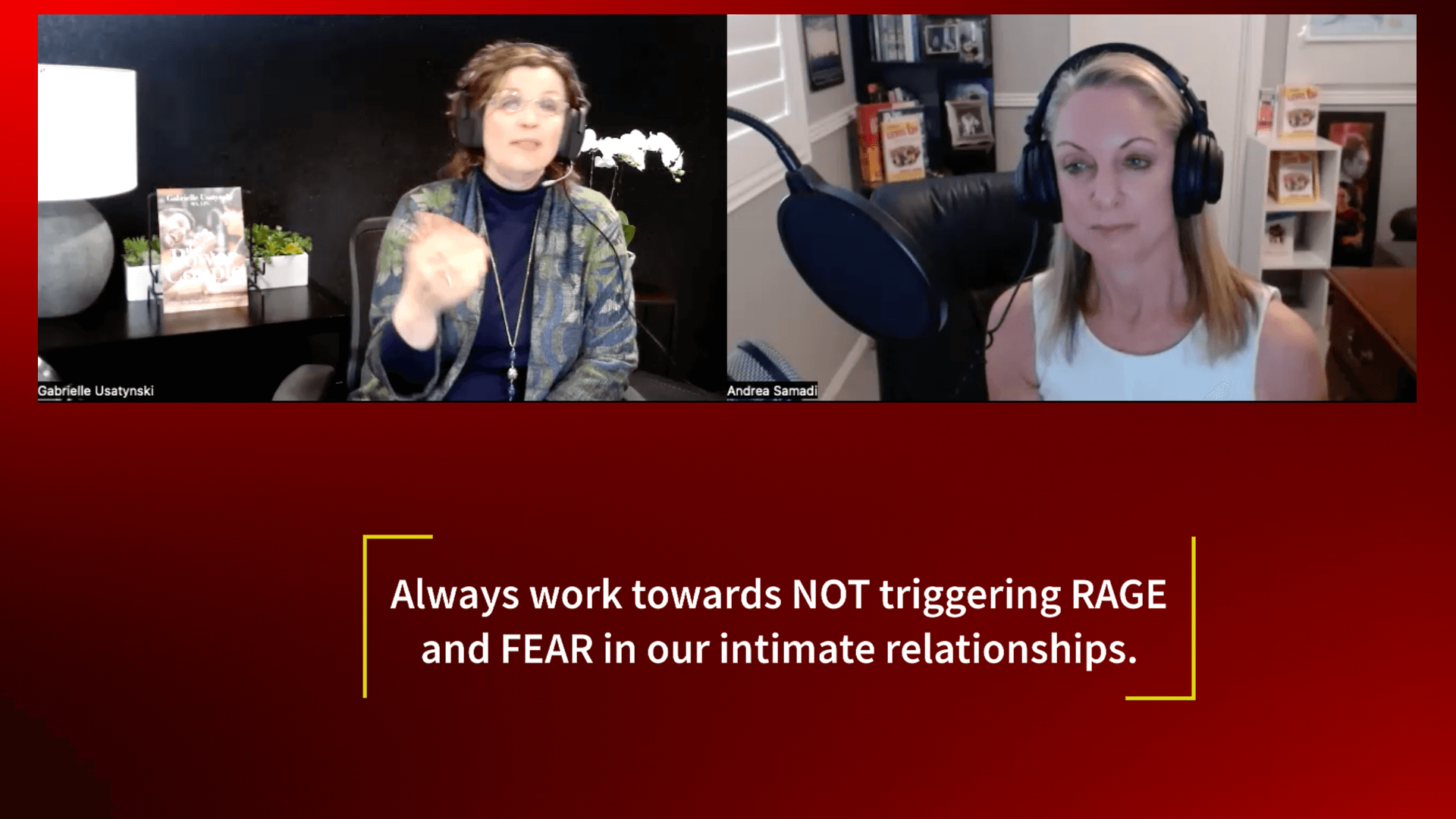
Chapter 7 of Gabrielle’s book covers the fear system, and Chapter 8 covers the Rage system, and she reminded us in our interview that we want to work towards NOT triggering rage and fear in our relationships. These are both good chapters to review for all of her tools and strategies for de-activating rage.
- What about you? Where have you noticed rage/anger come up in your life? Do you have a strategy to bring you some understanding that can help you to de-activate this emotion?
Fear: This emotion is a powerful one to look at. Have you ever thought of your deepest, innermost fears? I remember a program I did years ago, that asked us to look at what we were afraid of, and that to “know our fears” would help us to overcome them, or at least help us to move towards the idea of having “no fear.” I know exactly what I’m afraid of, and it’s there right in front of me daily, and I side-step around it most days, but I see it, whether it’s out of the corner of my eye, or I’m staring directly at it.
Now this isn’t even going into subconscious fears and traumas like Dr. Bruce Perry’s work, this is just looking at what we are consciously aware we are afraid of.
- What about you? Have you ever looked at this for yourself? Do you “know” your fears?
I think once we can identify them, then life just becomes easier. There’s no mystery with these fears. I don’t talk about what I’m afraid of, giving them more energy, but I know exactly what they are, and just knowing this, makes me feel that I’m more powerful than these fears. I can step around them, sometimes jump over them, when they come up, not letting them ever stop me from doing the things I want to do in life.
Who doesn’t want to be FEARLESS?
Taylor Swift says it nicely.

Lust: I’m not going to leave this one out, since everyone wants to talk about sex, and it is an important part of our most intimate relationships. Gabrielle covers this topic in Chapter 9 and 10 of her book, and when I was reading these chapters I was actually dying laughing because she made a comparison with sex, to a sport that will identify her as a Canadian. I’m not going to tell you the sport, but you’ll have to read the book to see how she made this comparison. She does say that most problems within relationships are a lack of the care system, they are not sexual.
When reading this chapter, I thought about how right she was that we have to have trust first here, and of the importance of repairing our relationships quickly and often so we don’t trigger the rage, fear of panic/grief circuit.
We’ve covered The Speed of Trust[iii] on past episodes with Stephen Covey who says that “trust is the glue to life” and “the one thing that affects everything else you’re doing.” Gabrielle mentioned that this system requires CARE that she outlines as commitment, availability, relief and empathy.
While we all know this core emotion is important, I wonder what Dr. Panksepp would say about other ways we can use this energy? If he were here, I’d ask him about Napoleon Hill’s Chapter on Sex Transmutation that we covered on EPISODE 195[iv] where Napoleon Hill, in his famous book, Think and Grow Rich, talks about how this powerful force can be “transmuted or transferred from one form of energy to another” which is a way of using this force to reach higher levels of achievement.
Care: Gabrielle covers this core emotion in Chapter 4 of her book, explaining why caring feels so good with the release of oxytocin, the bonding hormone and that “when you administer oxytocin to couples, they make more eye contact, are more self-disclosing, validate each other’s feelings more, and show a significant decrease in criticism, contempt, defensiveness, and stonewalling, Gottman’s four behaviors that predict divorce.” (page 81, The Power Couple Formula).
Looking at this system makes me think about how care existed in my household growing up. Not that I didn’t feel loved, but this system was definitely turned down, as affections weren’t openly discussed or shown, so it’s interesting to see that I want this system dialed up now that I’m raising my own children, and interacting with my husband, and this one is a work in progress for me. The key to understanding these core emotions is to think about how they show up in our life, gain a deeper level of self-awareness, and then find tools and strategies to improve how we show up in our relationships. This is exactly what Gabrielle wrote her book to accomplish.
- How does the core emotion of care show up for you?
- Are you able to easily show those close to you, who you love, that you care about them?
- If this doesn’t come naturally to you, do you have a strategy in place to dial this emotion up?
Panic/grief/response: Gabrielle covered this system thoroughly on our interview, explaining how it goes off when we are separated from those we love, or care about.
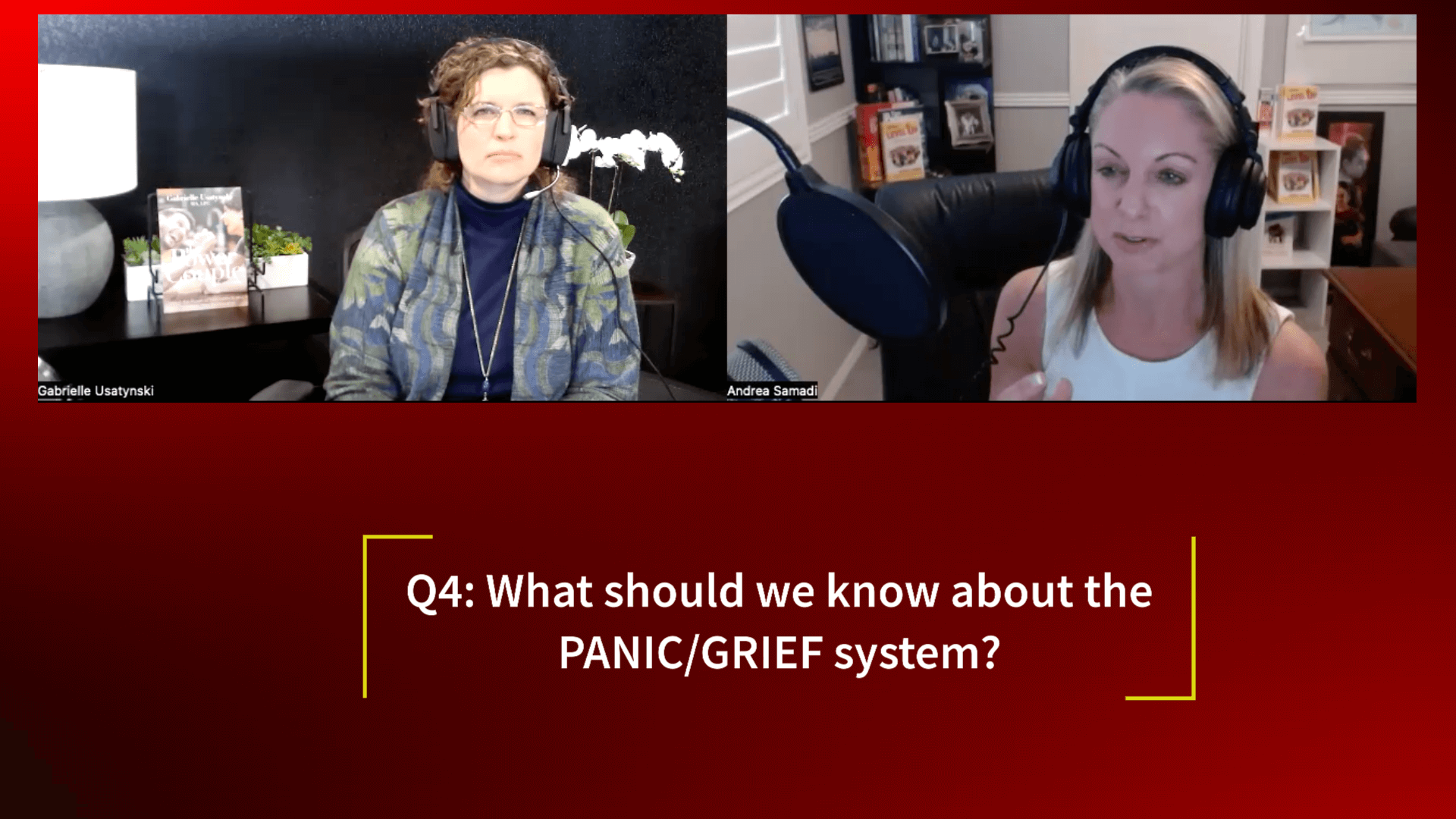
While she does suggest that in our close relationships we should always work on NOT triggering RAGE, FEAR or PANIC/GRIEF by being mindful of what sets these systems off in others, and working on keeping them in the OFF position.
But knowing your attachment style (and your partners’) helps here if you ever are faced with PANIC/GRIEF as it will shape the experiences you will have. Gabrielle covers extensively how each attachment style deals with PANIC/GRIEF.
- Do you know how YOU respond to PANIC/GRIEF in your relationships? If you are securely attached, this system rarely goes off. If you are anxiously attached, “you will worry that someone won’t be there for you consistently.” (page 36, The Power Couple). If you are avoidant, you will “have lost touch with unmet needs for connection and security.” (page 36, The Power Couple). Your attachment style will help you to understand yourself better, how quickly you will be able to recover from a breakup or even your ability to be apart from your partner without feeling panic.
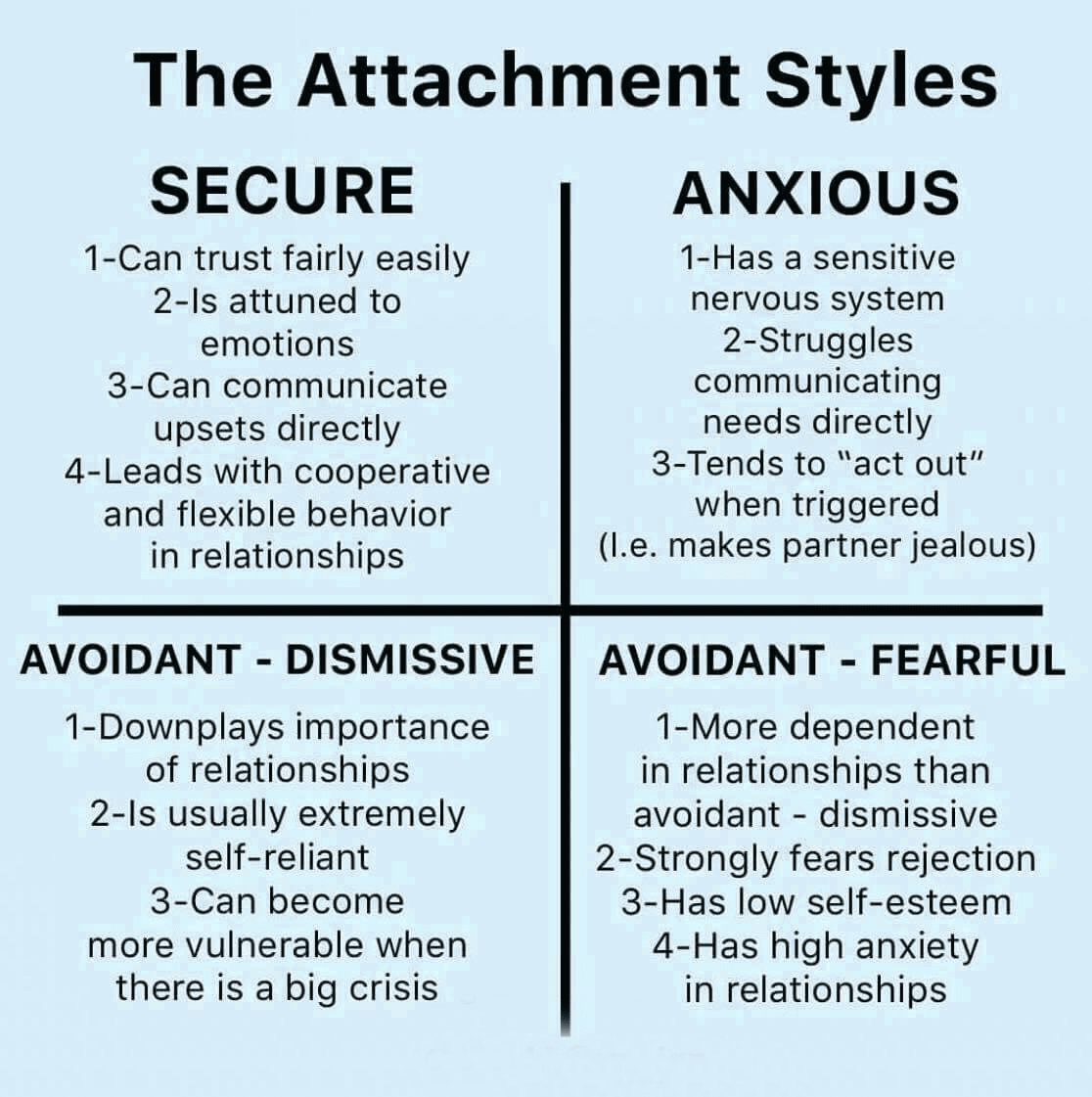
Play: This is the emotion I spent the most time learning about when I was first introduced to Dr. Panksepp’s work. Mark Robert Waldman who I took a neuroscience certification course with would have us thinking daily about how we would incorporate play with our work, to make it more enjoyable. When it comes to making neuroscience fun, this core emotion is vital. Or for students in the classroom in our schools, how can we make learning more fun?
My family tells me all the time “you are so serious, lighten up a bit” and I really do try, but I’m also the one who makes sure homework is completed each night, and day to day life stays on track, so I leave this part to others who are better at it than I am.
But who doesn’t want to have more fun every day? I’ve been playing around on the podcast, and working on having fun with interviews, but I’m not the type who will suddenly tell you a joke or something, or break out a fancy wrestling move with my kids which is what science would call “rough and tumble play” that Gabrielle says “reflects millions of years of evolution.” I’ve got some work here to add more fun into my day.
What about you?
- Do you have fun with your work?
- Do you think that play is only for children?
- Do you think that animals play?
Gabrielle covers this core emotion in Chapter 11 with Five Ways We Can Add Play into Our Relationships. The part I loved the most about this chapter, is that Gabrielle left this core emotion till the end of the book on purpose. Life is full of pressure and stresses and play only works “when its initiated in the absence of acute or chronic stress” (Page 295, The Power Couple Formula).
This is good to think about, as it’s important to be mindful of the stress levels of those around you.
Lucy Biven, co-author of The Archeology of Mind weighs in on the quote I posted at the beginning of this episode. Before releasing this, I wondered if I had a solid grasp of the quote I chose to open up this episode with, so I emailed Lucy Biven, who we interviewed on EPISODE #270 at the start of this year. Here’s as close to Dr. Panksepp as I could get to be sure we’ve got a handle of his 7 core emotions. She wrote:
“As for the quote - The hierarchy that Jaak wrote about was basically from bottom to top of the brain (brainstem to cortex). The hub of all 7 emotional systems is situated in the upper brainstem and in Jaak's view, emotional arousal always generates affective consciousness (emotional feelings). The hierarchy lies in the fact that without emotional arousal/affective consciousness, no consciousness is possible. So the upper brainstem is most important in generating consciousness - it is top of the hierarchy. How do we know that the brainstem is all-important? Tiny lesions so parts of the upper brainstem, specifically the parabrachial nuclei and the periaqueductal gray obliterate consciousness while quite large cortical lesions obliterate components of consciousness (sight, hearing, memory) but not consciousness itself. If my visual cortex were damaged, I would be blind, but I would know who I am, I would know who you are and I would understand my relationship with my children and grandchildren and I would retain everything that I know about neuroscience. In short, nothing else would change. But if I had a bad stroke in my upper brainstem, I would become comatose and vegetative. Everything would be lost.
The idea about the hierarchy from emotion to cognition is this: Emotions evolved in order to solve life problems. Some emotional responses are instinctive - for example, when frightened we freeze and might be overlooked by a predator. Others we learn, for example we discover from experience where the predator frequents and we avoid those places. Since emotional arousal is a precondition for cognition, we think about things that arouse our emotions. For example, if I am smart enough, I might set a trap for the predatory animal, thereby solving my problem for good. So cognition expands and refines emotional problem solving. That is the emotion/cognition hierarchy.
Jaak posited that in the emotion/motor hierarchy, emotions are primary because emotions are inherently linked to motor responses. I am not sure that he expanded on this beyond the observation that electrical (or pharmacological) arousal of emotional systems generates motor responses, like FEAR resulting in freezing or running away (depending on the strength of stimulation.
And with that, I’ll close out this episode on “How to Use Jaak Panksepp’s 7 Core Emotions to Transform Your Relationships, Family, Career and Life” and hope you found this deep dive into Gabrielle’s Power Couple Formula book to be as useful as I have.
I hope that if you print the list of the 7 core emotions, and put them in front of you, while you are working, that you can begin to think about how these emotions show up in your life day to day, and how you can use this understanding to develop stronger, more resilient relationships at home, with your family and in the workplace.”
Have a Happy Easter Weekend, and I’ll see you next week.
CONNECT with GABRIELLE
Gabrielle Usatynski, MA LPC
303-859-1825
https://powercoupleseducation.com
https://powercouplescounseling.com
Gabrielle's new book, The Power Couple Formula!
FOLLOW ANDREA SAMADI:
YouTube Channel: https://www.youtube.com/c/AndreaSamadi
Website https://www.achieveit360.com/
LinkedIn: https://www.linkedin.com/in/samadi/
Facebook: https://www.facebook.com/Achieveit360com
Neuroscience Meets SEL Facebook Group https://www.facebook.com/groups/2975814899101697
Twitter: https://twitter.com/andreasamadi
Instagram: https://www.instagram.com/andreasamadi/
RESOURCES:
Attachment Theory: Bowlby and Ainsworth’s Theory Explained By Saul Mcleod, Ph.D. Feb. 8, 2023 https://simplypsychology.org/attachment.html
The 4 Attachment Styles in Your Relationships and How to find Yours by Kelly Gonslaves March 10, 2023 https://www.mindbodygreen.com/articles/attachment-theory-and-the-4-attachment-styles
The Gottman Institute https://www.gottman.com/
The Four Horseman that can predict the end of a relationship https://www.gottman.com/blog/the-four-horsemen-recognizing-criticism-contempt-defensiveness-and-stonewalling/
REFERENCES:
[i] Neuroscience Meets Social and Emotional Learning Podcast EPISODE #270 with Lucy Biven https://andreasamadi.podbean.com/e/lucy-biven/
[ii]Neuroscience Meets Social and Emotional Learning Podcast EPISODE #280n wit Janet Zadina https://andreasamadi.podbean.com/e/pioneering-neuroscientist-janet-zadina-reflects-on-her-journey-of-bridging-neuroscience-and-education/
[iii]Neuroscience Meets Social and Emotional Learning Podcast EPISODE #207 on The Neuroscience of Trust https://andreasamadi.podbean.com/e/brain-fact-friday-on-the-neuroscience-of-trust/
[iv]Neuroscience Meets Social and Emotional Learning Podcast EPISODE #195 on “Think and Grow Rich PART 5: The Mystery of Sex Transmutation https://andreasamadi.podbean.com/e/think-and-grow-rich-book-review-part-5-on-the-power-of-the-mastermind-taking-the-mystery-out-of-sex-transmutation-and-linking-all-parts-of-our-mind/
No comments yet. Be the first to say something!